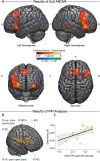The right inferior frontal gyrus processes nested non-local dependencies in music
- PMID: 29491454
- PMCID: PMC5830458
- DOI: 10.1038/s41598-018-22144-9
The right inferior frontal gyrus processes nested non-local dependencies in music
Abstract
Complex auditory sequences known as music have often been described as hierarchically structured. This permits the existence of non-local dependencies, which relate elements of a sequence beyond their temporal sequential order. Previous studies in music have reported differential activity in the inferior frontal gyrus (IFG) when comparing regular and irregular chord-transitions based on theories in Western tonal harmony. However, it is unclear if the observed activity reflects the interpretation of hierarchical structure as the effects are confounded by local irregularity. Using functional magnetic resonance imaging (fMRI), we found that violations to non-local dependencies in nested sequences of three-tone musical motifs in musicians elicited increased activity in the right IFG. This is in contrast to similar studies in language which typically report the left IFG in processing grammatical syntax. Effects of increasing auditory working demands are moreover reflected by distributed activity in frontal and parietal regions. Our study therefore demonstrates the role of the right IFG in processing non-local dependencies in music, and suggests that hierarchical processing in different cognitive domains relies on similar mechanisms that are subserved by domain-selective neuronal subpopulations.
Conflict of interest statement
The authors declare no competing interests.
Figures



Similar articles
-
Neural networks for harmonic structure in music perception and action.Neuroimage. 2016 Nov 15;142:454-464. doi: 10.1016/j.neuroimage.2016.08.025. Epub 2016 Aug 16. Neuroimage. 2016. PMID: 27542722
-
Music listening engages specific cortical regions within the temporal lobes: differences between musicians and non-musicians.Cortex. 2014 Oct;59:126-37. doi: 10.1016/j.cortex.2014.07.013. Epub 2014 Aug 12. Cortex. 2014. PMID: 25173956
-
Adults and children processing music: an fMRI study.Neuroimage. 2005 May 1;25(4):1068-76. doi: 10.1016/j.neuroimage.2004.12.050. Neuroimage. 2005. PMID: 15850725
-
A rostro-caudal gradient of structured sequence processing in the left inferior frontal gyrus.Philos Trans R Soc Lond B Biol Sci. 2012 Jul 19;367(1598):2023-32. doi: 10.1098/rstb.2012.0009. Philos Trans R Soc Lond B Biol Sci. 2012. PMID: 22688637 Free PMC article. Review.
-
Language, music, syntax and the brain.Nat Neurosci. 2003 Jul;6(7):674-81. doi: 10.1038/nn1082. Nat Neurosci. 2003. PMID: 12830158 Review.
Cited by
-
Musicianship-Related Structural and Functional Cortical Features Are Preserved in Elderly Musicians.Front Aging Neurosci. 2022 Mar 25;14:807971. doi: 10.3389/fnagi.2022.807971. eCollection 2022. Front Aging Neurosci. 2022. PMID: 35401149 Free PMC article.
-
Cortical Morphological Changes in Congenital Amusia: Surface-Based Analyses.Front Psychiatry. 2022 Jan 13;12:721720. doi: 10.3389/fpsyt.2021.721720. eCollection 2021. Front Psychiatry. 2022. PMID: 35095585 Free PMC article.
-
PPM-Decay: A computational model of auditory prediction with memory decay.PLoS Comput Biol. 2020 Nov 4;16(11):e1008304. doi: 10.1371/journal.pcbi.1008304. eCollection 2020 Nov. PLoS Comput Biol. 2020. PMID: 33147209 Free PMC article.
-
Resting-State Network Plasticity Induced by Music Therapy after Traumatic Brain Injury.Neural Plast. 2021 Mar 8;2021:6682471. doi: 10.1155/2021/6682471. eCollection 2021. Neural Plast. 2021. PMID: 33763126 Free PMC article. Clinical Trial.
-
Increased Functional Connectivity of the Angular Gyrus During Imagined Music Performance.Front Hum Neurosci. 2019 Mar 18;13:92. doi: 10.3389/fnhum.2019.00092. eCollection 2019. Front Hum Neurosci. 2019. PMID: 30936827 Free PMC article.
References
-
- Lerdahl, F. & Jackendoff, R. A Generative Theory of Tonal Music. (The MIT Press, 1983).
-
- Rohrmeier M. Towards a generative syntax of tonal harmony. J. Math. Music. 2011;5:35–53. doi: 10.1080/17459737.2011.573676. - DOI
-
- Steedman MJ. A Generative Grammar for Jazz Chord Sequences. Music Percept. 1984;2:52–77. doi: 10.2307/40285282. - DOI
Publication types
MeSH terms
LinkOut - more resources
Full Text Sources
Other Literature Sources

